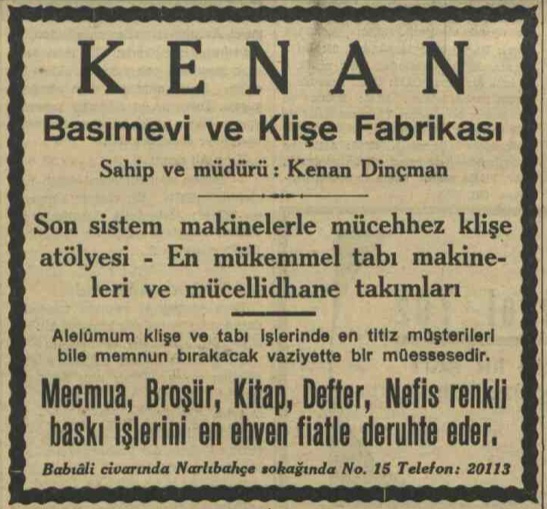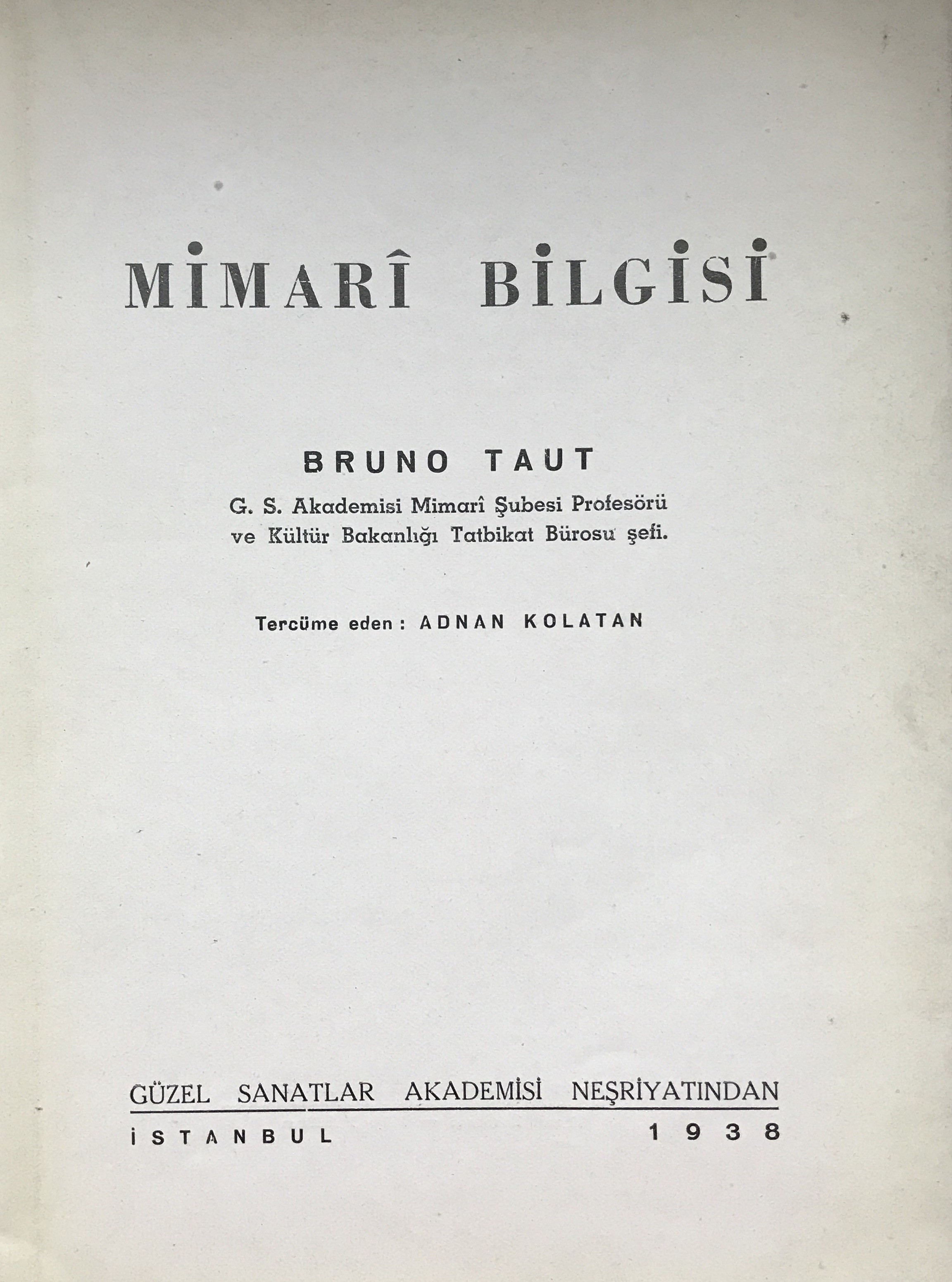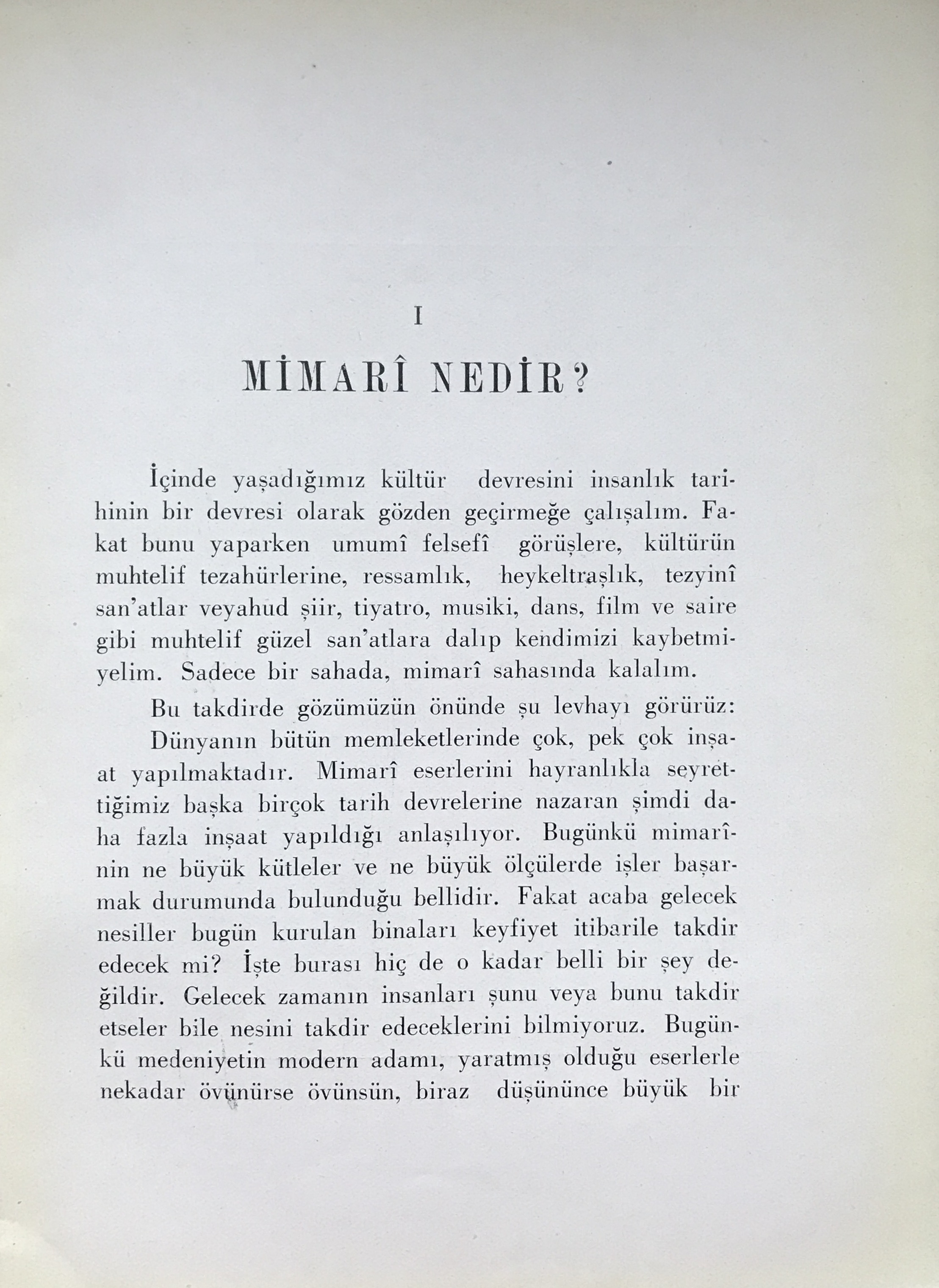Archive
Mimarî Bilgisi
- Book
Mimarî Bilgisi
Word Count: 2
- (Architectural Education)
- Bruno Taut
- 1938
Kenan Basımevi ve Klişe Fabrikası, Narlıbahçe Sokağı No. 15, Fatih, Istanbul.
- Turkish
- Istanbul (TR)
The architect Bruno Taut published his textbook Mimarî Bilgisi in 1938, only two years after his emigration to Istanbul, where he was appointed professor at the Academy of Fine Arts.
Word Count: 29

Bruno Taut, Mimarî Bilgisi, 1938, cover (Archive Burcu Dogramaci). 
Advertisement for Kenan Basımevi ve Klişe Fabrikası publishing and printing house which appeared in Akşam newspaper, 31 October 1937, p. 10 (https://www.gastearsivi.com). The owner Kenan Dinçman advertises the high quality of his printworks: “Son sistem makinelerle mücehhez klişe atölyesi – En mükemmel tabı makineleri ve mücellidhane takımları“. 
Bruno Taut. “Teknik.” Arkitekt, no. 9, 1938, p. 257 (http://dergi.mo.org.tr). Taut published a preprint of Mimarî Bilgisi in Turkey's first architectural journal. 
Bruno Taut, Mimarî Bilgisi, 1938, bastard title (Archive Burcu Dogramaci). 
Bruno Taut. Mimarî Bilgisi, 1938, reference to Kenan Basımevi ve Klişe Fabrikası publishing and printing house (Archive Burcu Dogramaci). 
Bruno Taut. Mimarî Bilgisi, 1938, foreword by the Minister of Culture and Education, Saffet Arıkan (Archive Burcu Dogramaci). 
Bruno Taut. Mimarî Bilgisi, 1938, contents list (Archive Burcu Dogramaci). 
Bruno Taut. Mimarî Bilgisi, 1938, page 1: "Mimarî nedir? – What is architecture?" (Archive Burcu Dogramaci). 
Bruno Taut. Mimarî Bilgisi, 1938, page 73: Villa Katsura (Archive Burcu Dogramaci). 
Bruno Taut. Mimarî Bilgisi, 1938, page 73: catafalque for Atatürk’s funeral, designed by Taut (Archive Burcu Dogramaci). 
Bruno Taut. Mimarî Bilgisi, 1938, page 156: Şehzade mosque (Archive Burcu Dogramaci). Akcan, Esra. Architecture in Translation. Germany, Turkey, & the Modern House. Duke University Press, 2012.
Dogramaci, Burcu. Kulturtransfer und nationale Identität. Deutschsprachige Architekten, Stadtplaner und Bildhauer in der Türkei nach 1927. Gebr. Mann, 2008.
Gezgin, Ahmet Öner. Akademi’ye Tanıklık. Güzel Sanatlar Akademisi’ne Bakişlar, vol. 2: Mimarlık. Bağlam Yayıncılık, 2003.
Gülsen, Ömer. “Erinnerungen an Bruno Taut.” Bauwelt, vol. 75, no. 39, 1984, pp. 1675–1676, 1683–1684.
Nicolai, Bernd. Moderne und Exil. Deutschsprachige Architekten in der Türkei 1925–1955. Verlag für Bauwesen, 1998.
Oelsner, Gustav. “Şehircilikte Abidevlilik.” [Monuments in urban development] Arkitekt, no. 11–12, 1945, pp. 265–270.
Önal, Maruf. “No Title.” Anılarda Mimarlık, Yem Yayınları, 1995, pp. 62–77.
Öz, Tahsin. Istanbul Camileri, vol. 1, Türk Tarih Kurumu Yayınları, 1962.
Özer, Ahmet. “Bruno Taut’un uzun yürüyüşündeki duraklar.” Ankara Üniversitesi Dil ve Tarih-Coğrafya Fakültesi 66. Kuruluş Yıldönümü Anı Kitabı, Ankara Üniversitesi Dil ve Tarih-Coğrafya Yayınları, 2003, pp. 21–30.
Tanju, Bülent. “Ein Aussenseiter der Baukunst in der Türkei: Bruno Taut.” Atatürk için düşünmek. İki eser: Katafalk ve Anıtkabir. İki Mimar: Bruno Taut ve Emin Onat = Für Atatürk gedacht. Zwei Werke: Katafalk und Anıtkabir, Zwei Architekten: Bruno Taut und Emin Onat (2nd edition), exh. cat. Technical University, Istanbul, 1998, pp. 26–28.
Taut, Bruno. “Proporsiyon.” Arkitekt, no. 7, 1938a, pp. 194–204.
Taut, Bruno. “Proporsiyon.” Arkitekt, no. 8, 1938b, pp. 233–237.
Taut, Bruno. “Teknik.” Arkitekt, no. 9, 1938c, pp. 257–260.
Taut, Bruno. “Teknik.” Arkitekt, no. 10/11, 1938d, pp. 317–323.
Taut, Bruno. Mimarî Bilgisi. Güzel Sanatlar Akademisi Neşriyatından. Kenan Basımevi ve Klişe Fabrikası, 1938.
Taut, Bruno. Architekturlehre. Grundlagen, Theorie und Kritik. Beziehungen zu den anderen Künsten und zur Gesellschaft. Architekturlehre aus der Sicht eines sozialistischen Architekten, edited by Tilmann Heinisch and Goerd Peschken, VSA, 1977.
Wittich-Taut, Erica to Isaburo Ueno. Bruno Taut Papers (Archiv der Akademie der Künste, Berlin, 1 February 1939), BTS 01-16 and 17.
Word Count: 306
Akademie der Künste, Berlin, Baukunstarchiv, Bruno Taut Papers.
Word Count: 9
- Istanbul
- Burcu Dogramaci. "Mimarî Bilgisi." METROMOD Archive, 2021, https://archive.metromod.net/viewer.p/69/2949/object/5140-10990232, last modified: 20-06-2021.
-
Rudolf BellingSculptorIstanbul
As a professor at the Academy of Fine Arts and Technical University in Istanbul from 1937 until 1966, Rudolf Belling taught his students the technicalities of form, material and proportion.
Word Count: 28
Bruno Taut HouseResidenceIstanbulArchitect Bruno Taut’s house in Ortaköy stands on a hillside with a panoramic view of the Bosporus, located at the point where Asia and Europe are closest to one another.
Word Count: 32
ArkitektMagazineIstanbulThe architecture magazine Arkitekt was an important platform for emigrated architects and urban planners such as Bruno Taut, Martin Wagner, Wilhelm Schütte, Ernst Reuter and Gustav Oelsner.
Word Count: 28
Margarete Schütte-Lihotzky and Wilhelm Schütte ApartmentResidenceIstanbulThe exiled architects Margarete Schütte-Lihotzky and Wilhelm Schütte lived from 1938 in an apartment in Kabataş, on the European side of Istanbul. The flat has been preserved in numerous photographs, allowing the interior design to be reconstructed. The view of the Bosporus from the balcony was spectacular.
Word Count: 48
Gustav OelsnerArchitectCity PlannerIstanbulGustav Oelsner became the founding father of urban planning in Turkey, his country of exile. He was also the author of numerous articles for the architectural journal Arkitekt.
Word Count: 28